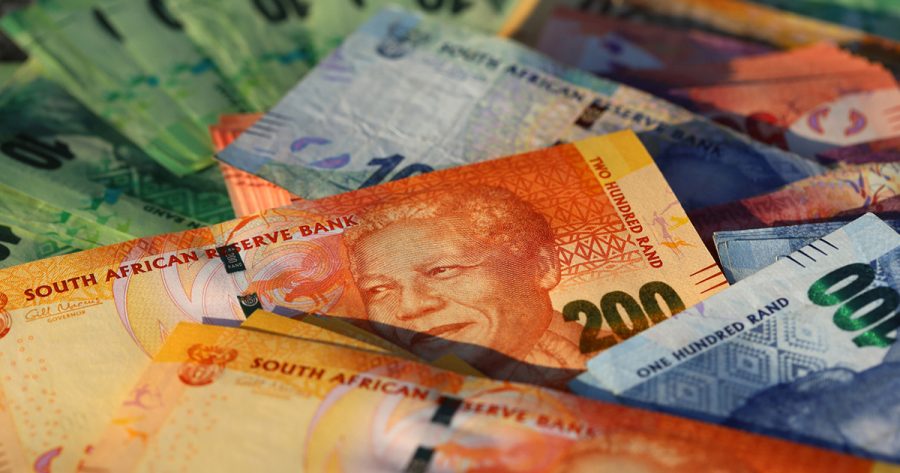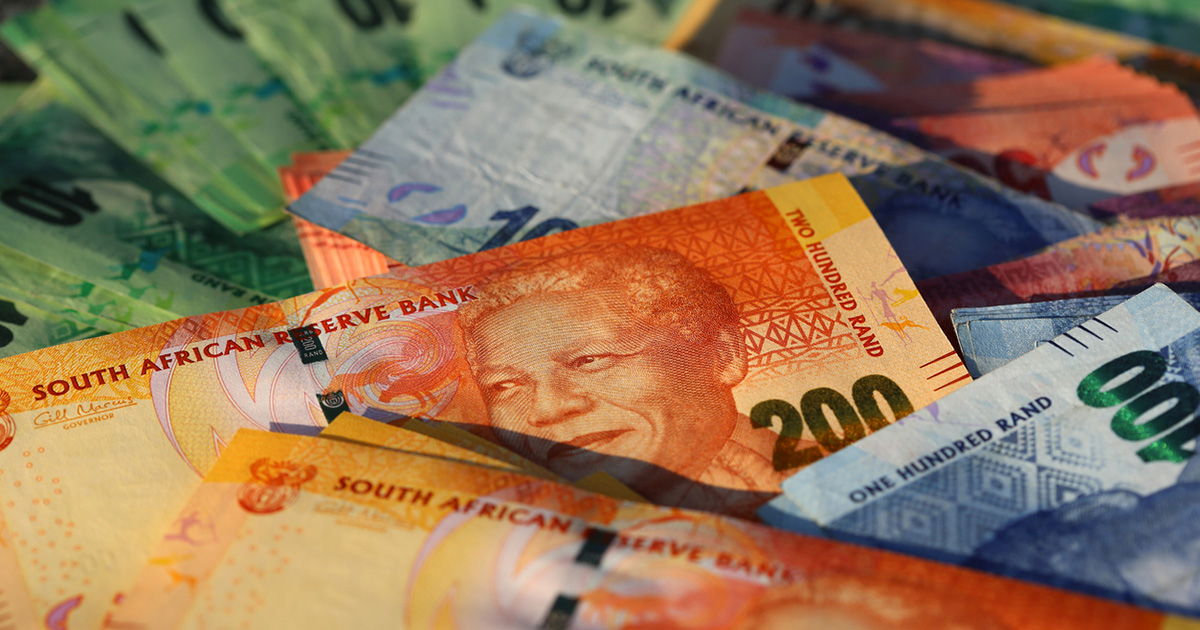
South African rand gained 1% as Pound struggles to hold ground
Reuters: The South African rand gained 1% on Monday, as investors watched for potential ripple effects of the aborted weekend mutiny in Russia. SOUTH AFRICAN RAND GAINED At 1210 GMT, the rand traded at 18.6000 against the dollar, around 0.84% stronger than its previous close after strengthening over 1% earlier. The dollar was last trading […]

Reuters: The South African rand gained 1% on Monday, as investors watched for potential ripple effects of the aborted weekend mutiny in Russia.
SOUTH AFRICAN RAND GAINED
At 1210 GMT, the rand traded at 18.6000 against the dollar, around 0.84% stronger than its previous close after strengthening over 1% earlier. The dollar was last trading 0.117% weaker against a basket of global currencies at 102.630. The market impact of a short-lived rebellion by Russian mercenaries on Saturday was still unclear, analysts said, with global oil prices slightly higher on concerns about Russian stability and crude supply. In local news, state utility Eskom said on Sunday that power cuts would be implemented at relatively low levels throughout the week, as fewer breakdowns at power stations had led to more generation capacity.
Many South Africans were facing power cuts of around 10 hours a day until recently, but there have been some signs of improvement in the last few weeks as the country grapples with its worst power crisis on record. “The rand is likely to remain volatile, influenced by global events more heavily currently, as lower load-shedding (power cuts) stages and President Ramaphosa’s recent efforts to strike a more neutral balance in global geopolitics have been overshadowed,” said Annabel Bishop, Investec’s chief economist, in a research note.
ALSO READ: Who are the richest South Africans in the world today? – 27 June 2023
German Foreign Minister Annalena Baerbock is due to visit South Africa on Tuesday and has said she would discuss the “dramatic developments in Russia” with the country. “I believe it is especially important now for me to meet and hold discussions with our South African partners, so that I can better understand how they view the current global situation,” she said before her departure. On the Johannesburg Stock Exchange, the blue-chip Top-40 index was last trading around 0.55% weaker than its closing level on Friday. South Africa’s benchmark 2030 government bond was stronger, with the yield down 8.5 basis points at 10.590%.
BRITISH POUND
Reuters: Sterling gave back early small gains against the dollar and euro on Monday as traders continued to grapple with the implications of the previous week’s outsized rate hike by the Bank of England. The pound was last flat against the dollar at $1.2712 , having earlier been up as much as 0.25%. That was a small rebound after its 0.83% decline last week, its biggest weekly drop since mid May. Sterling was also unable to hold onto its early gains against the euro, made after soft German business sentiment data. The European common currency was last up 0.28% at 85.90 pence. Monday’s moves in sterling followed the Bank of England’s larger-than-expected 50 basis point interest rate hike on Thursday, which pushed market pricing for the peak in the Britain’s key interest rate over 6%.
ALSO READ: Vuk Talks empowers youth to join artisanship sector
That implies further tightening of more than 100 basis points. In contrast, markets expect other major central banks to be near, if not at, their rate peaks. Traders are trying to assess whether this should mean a stronger pound, with currencies typically benefiting from higher rates compared to peers, or whether the ramifications for economic growth in Britain mean the pound will weaken. “Price action points to sterling being at an inflection point at which further rates hikes are no longer bullish for the currency,” said BNP Paribas analysts in a note.
The pound however hit a fresh seven-and-a-half year high against the under-pressure Japanese yen, reaching 182.98 yen before retreating after Japan’s top currency diplomat stepped up warnings against recent yen weakening. Speeches by several BOE policy makers will be closely watched this week. Governor Andrew Bailey speaks on Wednesday on a panel with top central bankers from the European Central Bank, Federal Reserve and Bank of Japan.
ALSO READ: Fuel price update: Good petrol news, bad diesel news
U.S. DOLLAR
Reuters: The dollar rose against the rouble on Monday, although it had pulled back from the 15-month high hit earlier in the session, while the Japanese yen gained modestly against the greenback following comments from the country’s top currency diplomat. After last being seen on Saturday night, the leader of the Wagner mercenary group, Yevgeny Prigozhin, whose weekend mutiny appeared to pose a major threat to Russian President Vladimir Putin’s 23-year-old rule, said he had never intended to overthrow the government. Prigozhin made no reference to his location or the deal that defused the mutiny. “We had that rapid escalation and just as fast de-escalation and it goes to show you this was a serious a threat for Putin to agree to terms to make a deal with Prigozhin,” said Edward Moya, senior market analyst at OANDA in New York. “It really looks like the focus will probably shift back until we have a clearer understanding of that to the global growth slowdown we are seeing.”
The Russian rouble weakened 0.90% versus the greenback at 84.40 per dollar after hitting its weakest level since March 2022. The dollar was softer against the yen, after Vice Finance Minister for International Affairs Masato Kanda said Japan was not ruling out any options in possible responses to excessive currency moves. The Japanese yen strengthened 0.16% versus the greenback at 143.48 per dollar. The Bank of Japan last intervened in the yen when it traded around 145 per dollar. “Whenever you have intervened and you have seen it work a little bit and then the price comes back to where you intervened in the past it’s like oh, start jawboning again,” said Moya.
ALSO READ: Who is the richest person in the world today? Top 10 list – 27 June 2023
The Japanese currency has come under pressure as the Bank of Japan has maintained its soft monetary policy, while central banks around the globe have embarked on a rapid path of hiking interest rates to combat stubbornly high inflation. The dollar index fell 0.049% at 102.680, with safe-haven support helping to keep it near the unchanged mark as concerns about a slowing global economy linger in the midst of aggressive tightening actions by multiple central banks around the globe. The euro up 0.21% to $1.0912 ahead of remarks by European Central Bank President Christine Lagarde at the ECB Forum on Central Banking in Sintra.
Earlier data in the region showed German business morale worsened for the second consecutive month in June, indicating that Europe’s largest economy faces an uphill battle to shake off recession. Sterling was last trading at $1.2719, up 0.06% on the day. In Asia, the dollar rose 0.40% against the offshore Chinese yuan to $7.2445 after hitting a 7-month high as investors braced for potentially more support measures as China returned from a holiday on Monday. Further stimulus measures were expected as from Beijing tries to bolster China’s flagging economic recovery.
ALSO READ: Cape Town’s covid informal settlement under water
GLOBAL MARKETS
Reuters: Asian stocks shook off earlier losses on Tuesday, helped by assurances that Beijing would support flagging growth in the world’s second-largest economy, which helped investors shift their focus away from risks around interest rates and Russia. The Chinese yuan also perked up significantly as central bank guidance sent a clear warning to traders that authorities were becoming less tolerant of the currency’s recent weakness. The shift in mood helped MSCI’s gauge of Asia Pacific stocks outside Japan widen gains to 0.66%, with Hang Seng Index and China’s benchmark CSI300 Index up 1.56% and 0.54%, respectively, by midday. Europe and Wall Street were set to open higher with FTSE futures up 0.3% at 0422 GMT and E-mini futures for the S&P 500 index climbing 0.21%.
In China, Premier Li Qiang said economic growth in the second quarter would be higher than the first and that Beijing would roll out more effective policies to expand domestic demand and open markets. “Good news is the rebound on the renminbi. It’s stabilising, and also the sentiment in the A-share market is improving,” said Steven Leung, executive director of institutional sales at broker UOB Kay Hian in Hong Kong. “I think people still expect there will be more policy coming out in July – more specific policies, how they will stabilise the economy and boost it in the third quarter,” Leung said.
ALSO READ: Home Affairs temporarily extends operating times
Li’s assurances come a day after S&P Global cut its forecast for China’s economic growth to 5.2% in 2023, down from an earlier estimate of 5.5%. It was the first time a global credit ratings agency has cut China’s forecast this year and follows lowered predictions by major investment banks including Goldman Sachs. The People’s Bank of China set the midpoint rate for the yuan at 7.2098 per U.S. dollar prior to market open, weaker than the previous fix 7.2056, but nearly 100 pips stronger than Reuters’ consensus estimates. State banks were also seen selling dollars on Monday, traders said, just ahead of the onshore domestic close to shore up the yuan’s closing price.
All of that helped the spot yuan trade firmer, alleviating more pressing concerns about the risks of capital flight from the mainland after weeks of sharp declines. “Further gradual yuan weakness, I think is one of the policy levers the PBOC will be quite content to see providing some support to the economy, if it can be done in that constrained and orderly fashion where there’s not a big outflow of capital,” said Rob Carnell, ING’s regional head of research, Asia-Pacific. In Hong Kong, NWS Holdings saw its shares rise 10% on Tuesday to hit a two-year high after it said a unit of conglomerate Chow Tai Fook had offered to buy about 97% of the construction firm’s stock for $4.53 billion.
ALSO READ: Fuel price LATEST: Good petrol, bad diesel news ahead of next week’s change
Geopolitical turmoil has in recent days dampened risk appetite following an aborted mutiny in Russia on the weekend, which appeared to reveal cracks in President Vladimir Putin’s grip on power. All three major U.S. stock indexes ended in the red on Monday, with megacap momentum stocks pulling the tech-heavy Nasdaq down the most. “Although the situation has subsided, any subsequent insurrection against Russia remains a potential cause for concern, potentially triggering a defensive reaction in safe-haven assets,” said Anderson Alves, a global macro analyst at ActivTrades. In energy markets, U.S. crude went up 0.52% to $69.73 a barrel at 0421GMT while Brent gained 0.51% to $74.56 a barrel. Spot gold added 0.3% to $1,928.5 an ounce. In currency markets, the dollar index was down 0.136%. Ten-year U.S. Treasury yields were steady in early Asia trade at 3.7154%. Two year yields fell 7 basis points to 4.671%.
Published by the Mercury Team on 27 June 2023
For more news on global and local market performance, follow our business and finance page.
